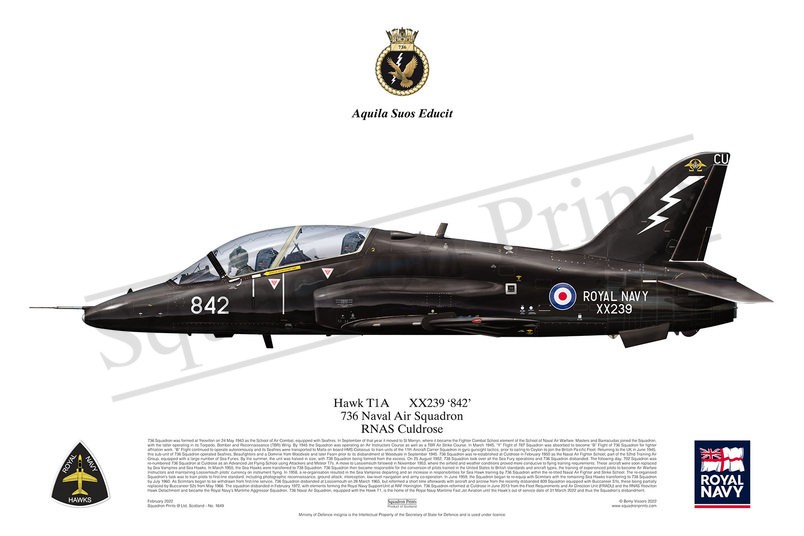#1649 736 NAS Hawk T1 print

Description
Squadron Prints Lithograph No. 1649 - XX239 '842', Hawk T1A, 736 Naval Air Squadron, RNAS Culdrose.
736 Squadron was formed at Yeovilton on 24 May 1943 as the School of Air Combat, equipped with Seafires. In September of that year it moved to St Merryn, where it became the Fighter Combat School element of the School of Naval Air Warfare. Masters and Barracudas joined the Squadron, with the latter operating in its Torpedo, Bomber and Reconnaissance (TBR) Wing. By 1945 the Squadron was operating an Air Instructors Course as well as a TBR Air Strike Course. In March 1945, “Y” Flight of 787 Squadron was absorbed to become “B” Flight of 736 Squadron for fighter affiliation work. “B” Flight continued to operate autonomously and its Seafires were transported to Malta on board HMS Colossus to train units of the 11th Aircraft Carrier Squadron in gyro gunsight tactics, prior to sailing to Ceylon to join the British Pacific Fleet. Returning to the UK in June 1945, this sub-unit of 736 Squadron operated Seafires, Beaufighters and a Dominie from Woodvale and later Fearn prior to its disbandment at Woodvale in September 1945. 736 Squadron was re-established at Culdrose in February 1950 as the Naval Air Fighter School, part of the 52nd Training Air Group, equipped with a large number of Sea Furies. By the summer, the unit was halved in size, with 738 Squadron being formed from the excess. On 25 August 1952, 738 Squadron took over all the Sea Fury operations and 736 Squadron disbanded. The following day, 702 Squadron was re-numbered 736 Squadron at Culdrose as an Advanced Jet Flying School using Attackers and Meteor T7s. A move to Lossiemouth followed in November 1953, where the airfield and weather conditions proved more conducive to flying training requirements. These aircraft were soon replaced by Sea Vampires and Sea Hawks. In March 1955, the Sea Hawks were transferred to 738 Squadron. 736 Squadron then became responsible for the conversion of pilots trained in the United States to British standards and aircraft types, the training of experienced pilots to become Air Warfare Instructors and maintaining Lossiemouth pilots’ currency on instrument flying. In 1958, a re-organisation resulted in the Sea Vampires departing and an increase in responsibilities for Sea Hawk training by 736 Squadron within the re-titled Naval Air Fighter and Strike School. The re-organised Squadron’s task was to train pilots to first-line standard, including photographic reconnaissance, ground attack, interception, low-level navigation and army co-operation. In June 1959, the Squadron began to re-equip with Scimitars with the remaining Sea Hawks transferring to 738 Squadron by July 1960. As Scimitars began to be withdrawn from first-line service, 736 Squadron disbanded at Lossiemouth on 26 March 1965, but reformed a short time afterwards with aircraft and aircrew from the recently disbanded 809 Squadron equipped with Buccaneer S1s, these being partially replaced by Buccaneer S2s from May 1966. The squadron disbanded in February 1972, with elements forming the Royal Navy Support Unit at RAF Honington. 736 Squadron reformed at Culdrose in June 2013 from the Fleet Requirements and Air Direction Unit (FRADU) and the RNAS Yeovilton Hawk Detachment and became the Royal Navy’s Maritime Aggressor Squadron. 736 Naval Air Squadron, equipped with the Hawk T1, is the home of the Royal Navy Maritime Fast Jet Aviation until the Hawk’s out of service date of 31 March 2022 and thus the Squadron’s disbandment.
You may also like
-
Gripen Flight Test Centre, SAAB Gripen 39E print
4100; 6001Saab AB; Gripen Flight Test CentreGaviäo Peixoto -
Hawk Mk65
8810The Royal Saudi Air Force Aerobatic Team, The Saudi Hawks, 88 SqnTabuk, King Falsal AB -
SALE RIAT 2015 Print F-5, F-16, Typhoon, Spitfire, P-1
P7350 'EB-G'; 505; ZK349 'GN-A'; 5507; AE.9-010 '23-04'RIAT 2015RAF Fairford
